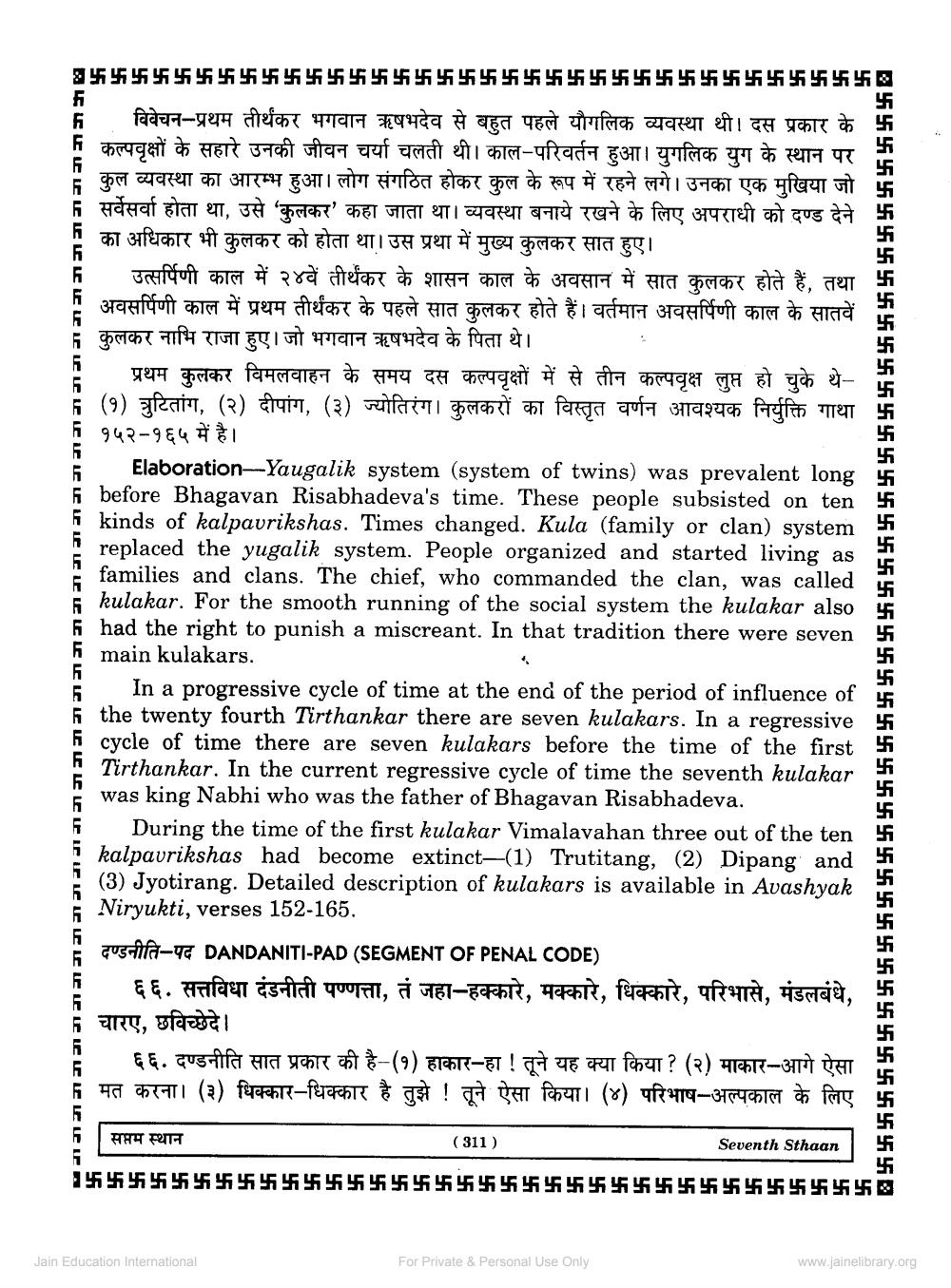________________
355555555555555))))
)))))))
))))
ALLE LELLE LE LLC LL
LC LC LE
Lr
ir
ELC
विवेचन-प्रथम तीर्थंकर भगवान ऋषभदेव से बहुत पहले यौगलिक व्यवस्था थी। दस प्रकार के के म कल्पवृक्षों के सहारे उनकी जीवन चर्या चलती थी। काल-परिवर्तन हुआ। युगलिक युग के स्थान पर । कुल व्यवस्था का आरम्भ हुआ। लोग संगठित होकर कुल के रूप में रहने लगे। उनका एक मुखिया जो ॐ । सर्वेसर्वा होता था, उसे 'कुलकर' कहा जाता था। व्यवस्था बनाये रखने के लिए अपराधी को दण्ड देने का अधिकार भी कुलकर को होता था। उस प्रथा में मुख्य कुलकर सात हुए।
उत्सर्पिणी काल में २४वें तीर्थंकर के शासन काल के अवसान में सात कुलकर होते हैं, तथा । अवसर्पिणी काल में प्रथम तीर्थंकर के पहले सात कुलकर होते हैं। वर्तमान अवसर्पिणी काल के सातवें म कुलकर नाभि राजा हुए। जो भगवान ऋषभदेव के पिता थे।
प्रथम कुलकर विमलवाहन के समय दस कल्पवृक्षों में से तीन कल्पवृक्ष लुप्त हो चुके थे। (१) त्रुटितांग, (२) दीपांग, (३) ज्योतिरंग। कुलकरों का विस्तृत वर्णन आवश्यक नियुक्ति गाथा है १५२-१६५ में है।
Elaboration-Yaugalik system (system of twins) was prevalent long before Bhagavan Risabhadeva's time. These people subsisted on ten kinds of kalpavrikshas. Times changed. Kula (family or clan) system replaced the yugalik system. People organized and started living as families and clans. The chief, who commanded the clan, was called
kulakar. For the smooth running of the social system the kulakar also F had the right to punish a miscreant. In that tradition there were seven F_main kulakars.
In a progressive cycle of time at the end of the period of influence of ī the twenty fourth Tirthankar there are seven kulakars. In a regressive Ficycle of time there are seven kulakars before the time of the first
Tirthankar. In the current regressive cycle of time the seventh kulakar was king Nabhi who was the father of Bhagavan Risabhadeva.
During the time of the first kulakar Vimalavahan three out of the ten kalpavrikshas had become extinct-(1) Trutitang, (2) Dipang and (3) Jyotirang. Detailed description of kulakars is available in Avashyak Niryukti, verses 152-165. दण्डनीति-पद DANDANITI-PAD (SEGMENT OF PENAL CODE)
६६. सत्तविधा दंडनीती पण्णत्ता, तं जहा-हक्कारे, मक्कारे, धिक्कारे, परिभासे, मंडलबंधे, चारए, छविच्छेदे।
६६. दण्डनीति सात प्रकार की है-(१) हाकार-हा ! तूने यह क्या किया? (२) माकार-आगे ऐसा । मत करना। (३) धिक्कार-धिक्कार है तुझे ! तूने ऐसा किया। (४) परिभाष-अल्पकाल के लिए
555555555555555555555555555555555555555555555555558
रागागागागागागागागागागागागागागा
सप्तम स्थान
(311)
Seventh Sthaan
15牙牙牙牙牙牙牙牙牙牙牙牙牙牙牙牙牙牙牙牙牙%%%%%%%%%%
Jain Education International
For Private & Personal Use Only
www.jainelibrary.org




